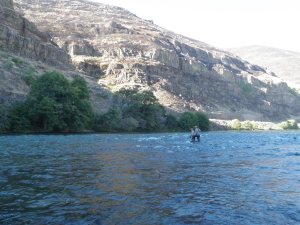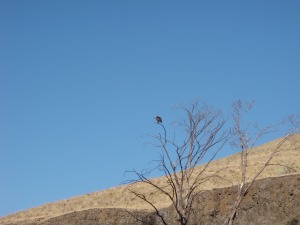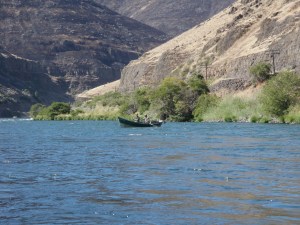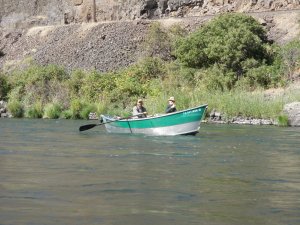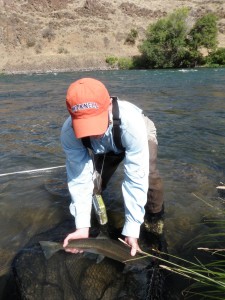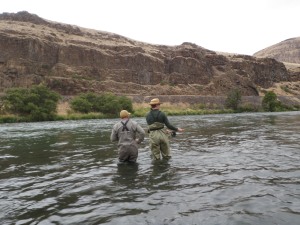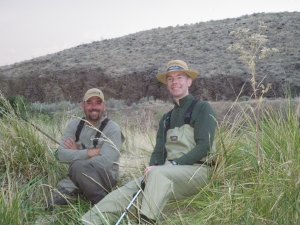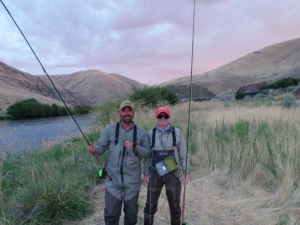Time: 6:30AM – 8:00PM
Location: Maupin to end of dirt road
Fish Landed: 2
Deschutes River 08/24/2011 Photo Album
I’ve always been drawn by the allure of the Deschutes River and in particular catching a steelhead. When I withdrew from the Hood to Coast Relay due to an injury to the outside of my right pelvis, I decided to fly to Oregon early and book a guided fishing trip on the Deschutes. Amy’s friend in Portland, Aaron Tersteeg, agree to join and recommended a guide service. I called Deschutes Canyon Fly Shop and booked a steelhead trip for August 24. The shop informed me that my guide would be Gil, and we needed to meet him at 5:00AM. Because of the early meet time, Aaron booked a room in the Deschutes Hotel in Maupin for Tuesday night.
Aaron was detained somewhat on Tuesday night, but we left Portland at around 7:30. We stopped in Sandy and purchased some food for breakfast on Wednesday. We arrived at the hotel on Tuesday night and set our alarms for 4:30 Wednesday morning and immediately went to bed.
We were up on time on Wednesday morning and drove to fly shop where we met Gil a bit after 5AM. We transferred all our gear to Gil’s truck and left for the launch point. As we were driving north along the river, we realized we hadn’t transferred wading staffs, and Gil felt these were essential, so we did a U turn and returned to Aaron’s car for the staffs.
Now we had everything so we covered the same road and continued to a dirt section and then to the boat launch. The sun had not yet crept over the canyon rim, so it was still very low light as we began. In fact the sun would not appear in the canyon until around 9:30AM. This was the point of the early start as steelhead prefer low light conditions to bite on flies.
We drifted downstream a bit until we came to a spot where there was a nice long riffle of moderate depth. The Deschutes was flowing at 4,250 cfs. This is very high flows by Colorado standards, but Gil said it was ideal and normal for this time of year. Gil also reported that quite a few steelhead had already migrated into the Deschutes from the Columbia. Many apparently detour to the Deschutes but ultimately return to the Columbia and swim further up that river to spawn. We were fishing to summer run steelhead and it was early in the season.
Aaron got out first and fished the top half of the run while I started at the middle and fished to the end. We would continue sharing water like this for the remainder of the day, but alternating between the top and middle. Gil pulled two huge two-handed spey rods from the boat and began instructing Aaron on the casting process. Once Aaron was set up he took me down the river a bit and walked me through the same process.
When the river was flowing left to right, the cast began with a sweep of the rod tip across the front of the body, and then a pause. Next I swept the rod back across the front of my body and then back to vertical with my left hand against my ribs and right hand just off my right shoulder. The last move was a powerful roll cast which shot the line out and across the water. Gil stressed the key of pulling down with the left hand hard and using the left to generate more forward thrust than the right arm. Once the line was out I made a huge upstream mend and then gradually pointed the rod tip at the line depending on how fast the current was. The fly was allowed to swing down and across to a point below me. When the swing was complete, I took three or four steps downstream and repeated everything over again. If the river was flowing right to left there was an added step of flinging the line upstream before beginning the across the front of the body sweep.
We repeated this whole process over and over during the morning. Drift in the boat to a good area, get out of the boat, perform the casting steps, take three or four steps, get back in the boat at the end of the target area, and drift to a new spot. As we drifted downstream we covered some runs where we could see steelhead darting away from the boat, so we knew there were definitely fish in the river. There were a few bank bound fishermen but very few competing guides and fishermen.
At around noon Gil began looking for one of his favorite lunch spots, but we discovered two drift boats pulled up on the beach so moved further downstream. Not much beyond the preferred spot Gil pulled the boat up on shore, and we prepared for lunch. Gil unfolded a table and spread a tablecloth then carried sandwiches and potato salad and chips to the table. By now the sun was directly overhead and beating down mercilessly on the three of us. Aaron removed his waders, but I used bad judgment and kept mine on. As we ate Gil asked us to look to the west and a bank of gray clouds was forming on the horizon. By some act of mercy, the clouds rolled in and blocked the sun just as we prepared to resume fishing after lunch. We were spared the intense desert heat over the remainder of the afternoon as the clouds blocked the sun much of the time.
We’d drifted downstream for another couple hours when we came to a spot with a long side riffle on the west bank. It was around 3:15 when I got out first and began fishing at the top of the run. This run wasn’t quite as deep and fast as others. I’d probably worked down through three or four cast repetitions when all of a sudden a fish hammered my fly. By the way, we used the most ridiculously gaudy flies you could imagine. Mine was pink and red and silver tinsel in a long skirt around the shank with an articulated hook extending beyond the end of the skirt. The fly had heavy beadhead eyes on the front. At any rate, the fish hammered the fly and stripped line from my hand and pulled out the slack that I accumulated for shooting casts. The fish’s first move was to jump and clear the water. I’d called to Gil who grabbed the giant net and was quickly making his way up the bank, and he and Aaron were awed by the jump. I was happy about the hook up, but frankly the huge spey rod made fighting and landing the fish much less exciting than what I’d experienced on my Alaska trip with my 6 weight fly rod.
The fish now shot upstream and above me as I quickly stripped line to maintain tension. When it got above me it crossed back and forth several times and then just as Gil arrived it made one more spurt directly upstream. Once that move stopped I applied pressure and brought it toward the bank where Gil slide the net beneath, lifted and landed my first steelhead. It was a beautiful fish with pink sides and the steely cheeks that give the treasured fish their name. Gil estimated the fish to be 26 inches long, but because of the size of the net and the rod, it didn’t seem as much of an accomplishment as the 24 inch fish I’d landed in Alaska. But I was quite excited nonetheless after a fishless morning, and I’d about given up hope of catching any.
Gil took my camera and snapped a photo as I was about to lift it and then a portrait style of me holding the fish. I asked him to take one landscape style as my electronic picture frame cuts off the top and bottom of portrait style photos. Once photos were over Gil gathered the fish to gently release, but before he could lower it to the water, the fish made a huge leap and jumped into the river and swam away. Gil told me my steelhead was a native and therefore needed to be released. Hatchery steelhead may be kept and can be recognized by clipped fins. We high fived, and I took a deep breath and resumed covering the water.
We continued floating and fishing relentlessly. As the sun dropped beyond the canyon rim to the west the water was covered in shadows. I noticed a pretty decent hatch of tiny mayflies with a light yellow olive body and then as the daylight waned caddis began to flutter everywhere. There were some sporadic rises by resident trout and on one of my swings I felt a bump and brought to hand an eight inch rainbow trout.
By 6:30PM we stopped at another side run and I climbed out to fish the top section. This run was narrower than most and the current faster as I began covering the water. There were some trees near the mid-section between me and Aaron. The water was swift but then quickly slowed to almost a still pool so I was having issues with the heavy fly getting hung up on the large submerged rocks directly below me as I took my three steps before recasting. After this happened two or three times, I got lodged on some rocks again and allowed the line to float beyond the snag and generated a massive yank to free the flies. But as the fly resettled something grabbed it and began ripping line out downstream. Because this was a variation from the swing method I’d been employing all day long, I made a tactical error and grabbed the fly line streaking from my rod. In a split second the steelhead continued and snapped off the fly. It is hard to describe the disappointment when you’ve fished hard all day, and finally get an opportunity for a second fish and make an error.
We continued fishing in the fading light in some runs that Gil described by name and mentioned as some of the best on the river. I was re-energized after the blunder but gradually faded as the clock ticked toward 8PM. By 8 Aaron and Gil were sitting on the bank watching me, and I was feeling extremely fatigued from casting the big spey rod and stumbling over slick slimy rocks all day long. I announced an end to the day and we snapped some photos on the west bank and then climbed back in the drift boat and floated to the take out.
We returned to Maupin via the rough washboard dirt road and transferred everything back to Aaron’s car. I suggested that Aaron drink a Red Bull for the return drive, but he felt alert. We made it back to Aaron’s house by midnight and hit our beds by 12:30AM. It was quite a day.


